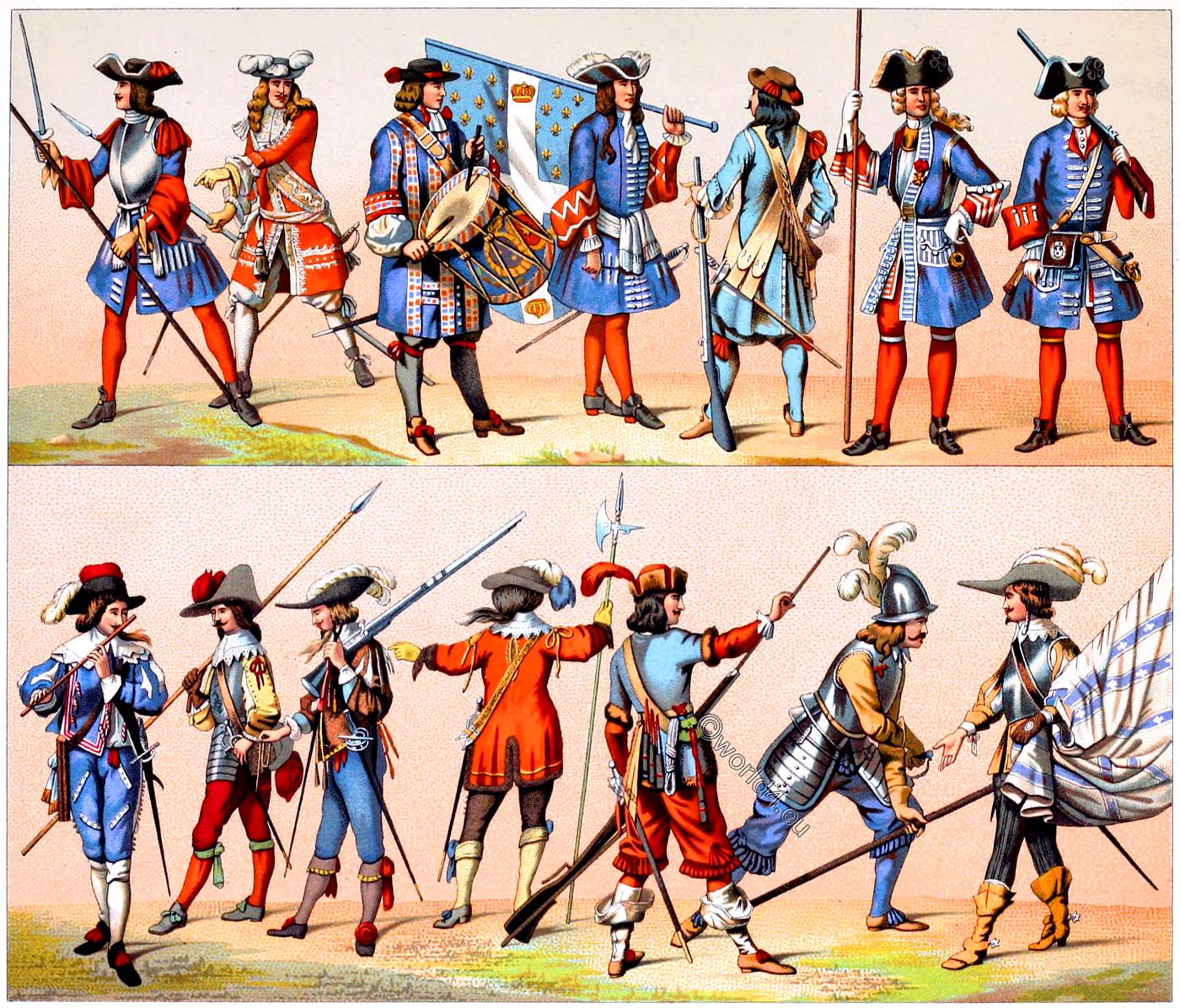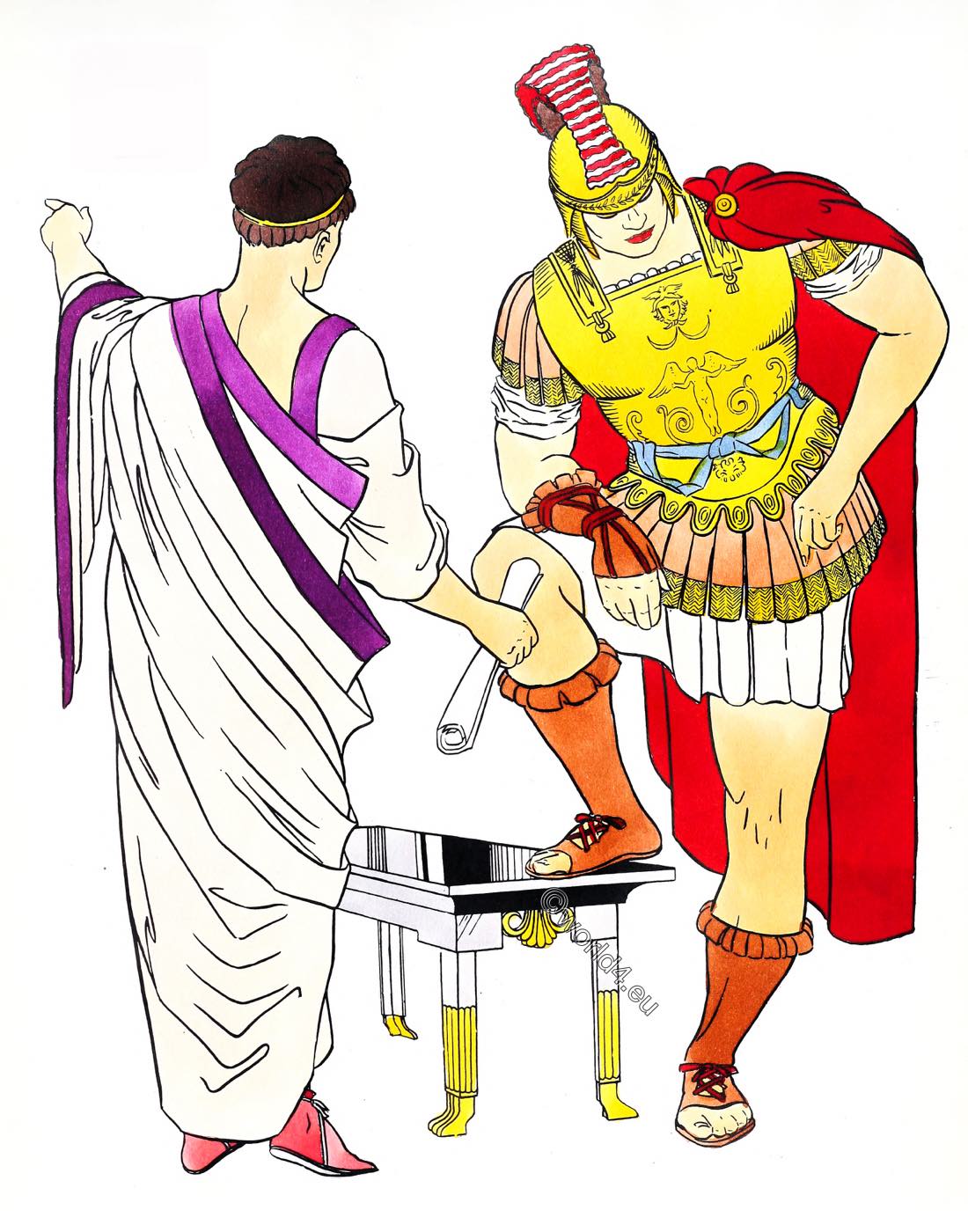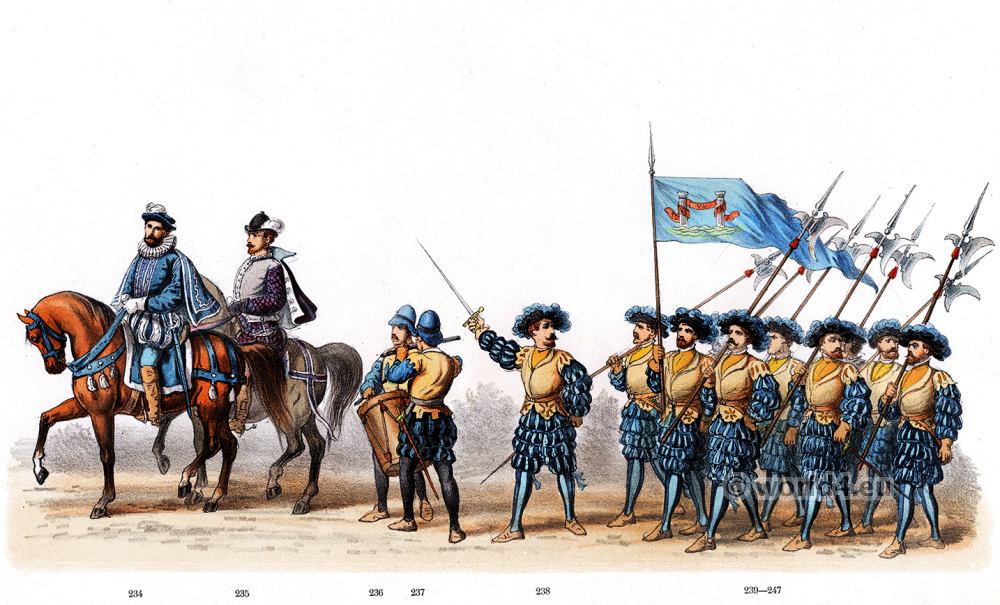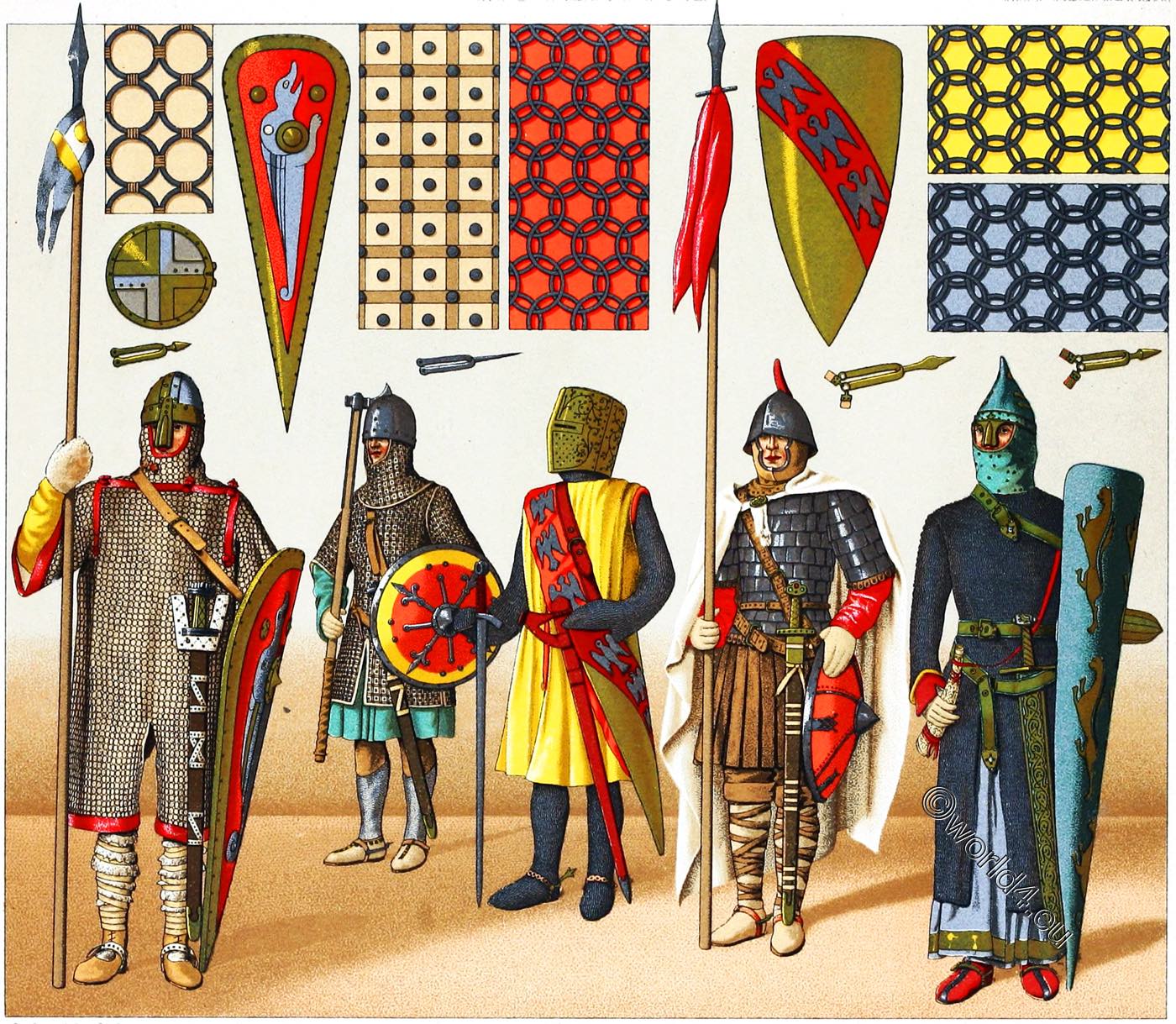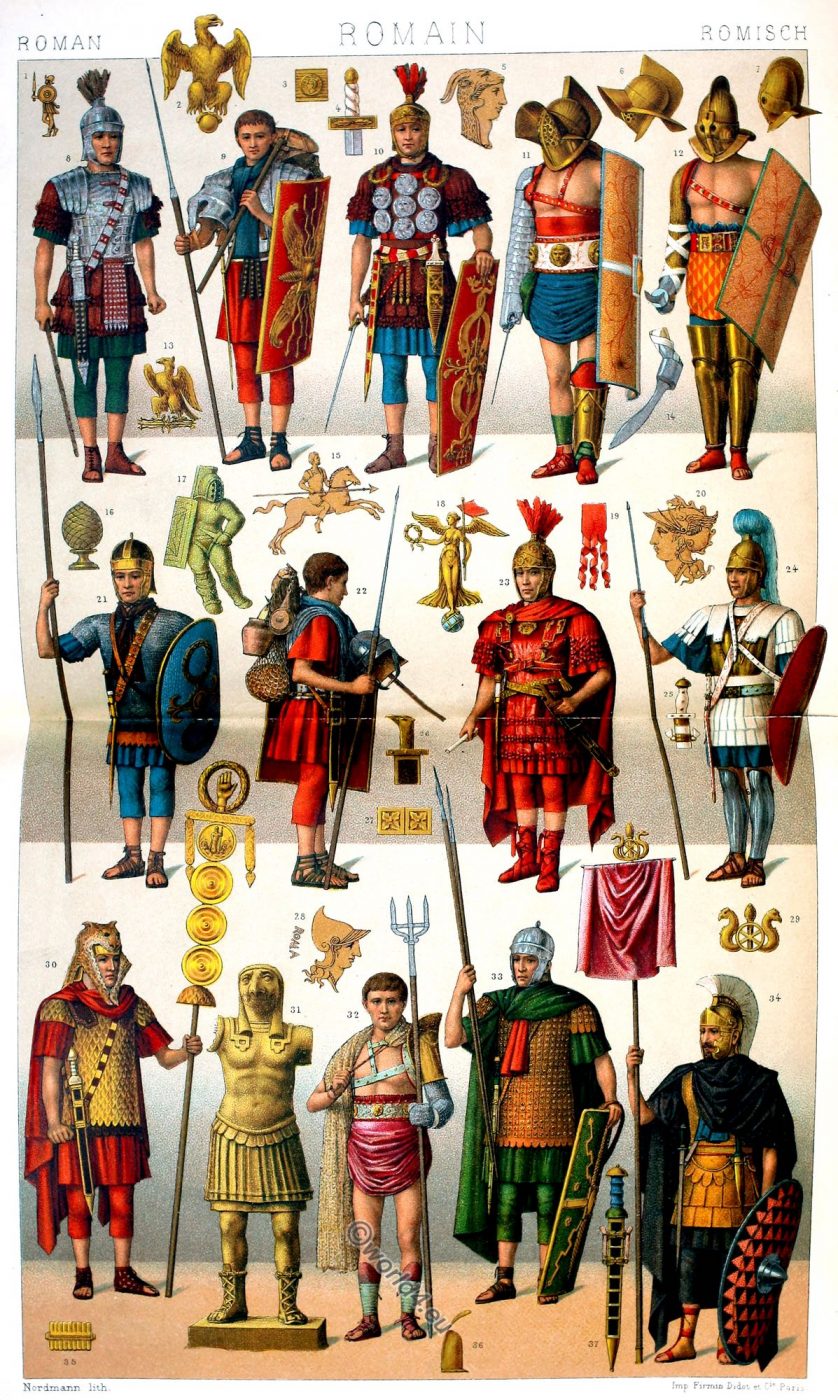
THE ARMING OF ROMAN SOLDIERS AND GLADIATORS AFTER THE LAST PERIOD OF THE REPUBLIC.
The legionnaires: The triarii, the impediti, the eques, the Centurio, the phaleratus, the military tribune – Caesar Imperator. – The signifer, the vexillarius. The gladiators: the mirmillo, hoplomachos, the retiarius. – The Roman eagle etc.
No. 24. – The triarius; after a bas-relief in the Louvre.
No. 25. – Detail of his armour. The armour is almost entirely that of the Greek warrior. The triarii got their name after one had lent the pilum also to the hastati and principes as weapon, probably from their position in the third row of the battle order of the Legion. In the last time of the republic, when one introduced the formation after cohorts, this designation disappeared.
Bronze helmet with cheek flaps and comb with hair bush. – Tunic similar to the leather or linen armour of the Greeks with armpits and waist apron. – Woolen subarmal with short and wide sleeves. – Bronze pectoral. – Bronze sword worn on the right side (cf. no. 25). – Balteus, bandelier of painted leather. – Copper cinctoriuum with bronze nails. – Cuemides with leather lining. – Pilum, with iron tip 0.22 m long. – Parma, round shield. – Leather crepides.
No. 1. Military greeting of the Roman soldier; the bare sword held straight in front of the body. After a medal with the inscription C. Servil.
No. 9 and 22. The impeditus, legionary after a relief of the Trajan column, seen from two sides. The soldier is shown in full field equipment with luggage. Iron helmet, cassis, with a ring to hang it on the march on the right side of the tank. – subarmale of wool. – Foemoralia, short Gallic trousers, mainly for the campaigns in the north. – Focale, woollen scarf. – Caligae with nailed soles. – Lorica, consisting of two wide breast plates and several steel rails covering shoulder and waist. – Small leather belt with stripes falling over the tunic. – Balteus, leather building workshop. – Gladius of Iberian form, longer and heavier than the Greek sword, in leather or wooden sheath. – Square scutum of painted wood with emblem. – Pilum, lance with long point.
The infantryman’s luggage was carried at the end of a long staff. It consisted of a rolled coat, sagulum; a leather hose with water; a leather bag; an iron pot and spoon; and a net with bread and meat. The soldiers of Marius were called muli mariani after this burden introduced by him.
No. 33. Legionary soldier of the eastern provinces of the Roman Empire after a bas-relief of the Trajan Arch, which was later transferred to the Arch of Constantine.
No. 37. – Detail of his armor. Tunic made of several layers of leather with bronze buttons. – Cassis with neck guard, jaw flaps and ring to hang. – Subarmal and focmoralia of the same colour. – Sagum, a square piece of fabric, serving as blanket and coat. – Leather balteus, sword handle and scabbard as well. – Two javelins. – Scutum with leather strap. – Caligae in two parts, laced over the instep, releasing the toes.
No. 15 – Horseman, attacking with lowered lance, from a commemorative coin of the Spanish campaigns with the inscription Segovia and Hispania.
No. 21. – Eques, rider; according to a relief of the Trajan Column. Chain mail shirt over a leather yoke. – Balteus, made of leather with a sword, longer than that of the infantryman. – Parma of painted wood with bronze rim. – Lancea with lanceolate tip. – Caligae in leather. – Spur on right foot.
No. 8. – Centurio.
The Centurio, leader of the Manipel, was appointed by the tribunes. His command was immediately before the flag.
Helmet with silver plated comb and dark feather bush. – Bucculae, jaw flaps in hinges movable. – Subarmal and foemoralia of same fabric and same color. – Leather yoke with an apron from a double row of leather strips. – Steel chest armour and shoulder pieces. – Silver embroidered balteus. – The scabbard with silver fittings after an original in the Museum of Naples. – Belt with stripes falling over the apron. – Campagus, boots leaving the toes free, laced. – In the hand a stick from grapevine, with which the soldier was punished with offences.
No. 10. – Phaleratus, a military tribune of the Rhine army, after a tombstone.
No. 3 and 4. – Details of his armour. Under the legatus or praefectus legionis the military tribunes stood at the top of the cohorts, usually six.
The phalerae were round plates made of gold, silver or other metals with the image of a god, general, emperor or with other emblems. They were awarded as military decorations and worn on the chest. The phaleratus depicted here is also decorated with torques, a chain of spirally wound gold wire.
Gold plated helmet with crista of black and raw feathers. – Tunic with apron from a double row of leather strips. – The Celt-Iberian sword (see no. 4) in a scabbard decorated with imperial portraits in bronze (see no. 3) at the cinctorium. – Parazonium, a short dagger on the left side. – Scutum, pentagonal of painted wood with bronze ornaments. – Caligae, closed boots in the style of the campagus.
No. 23. Caesar Emperor at the time of Anthony.
No. 19, 26 and 27. – Details of his armor. Purple dress. Gold plated bronze helmet with purple feather bush. Leather collar with embroidered shoulder pieces and rolled ribbon hangers (see no. 19) and a triple striped apron. – Gold embroidered leather belt at the height of the thorax. – Sword with gilt blade and ivory handle. – Cinctorium made of gilded bronze plates (see no. 27). – Paraconium with bronze-decorated leather cover (cf. no. 26). – Ivory baton. – Paludamentum, military coat, wider than the sagum, attached to the shoulder by a fibula. – Closed purple boots, higher than the campagus. – Gorgonian head in the middle of the breastplate, winged flashes on the shoulder pieces, on the cover of the parazonium and on the cheek flaps.
No. 30 – signifier, flag bearer of the infantry; according to a relief of the Trajan column (Columna Traiana).
No. 35. – Detail of his armor. The Legion had only one eagle and one aquilifer, each cohort a signifer. The Manipel, an underhealing of the cohort, led as signum the concordia, composed of fathers and an outstretched hand.
Bronze cassis, covered with a panther fur. – Subarmale. Pants and sagum of red color. Lorica squamata, made of metal scales, sewn on leather. – Sword with ivory handle in a leather sheath covered with gilded bronze (see no. 35). – Bolteus of leather with bronze ornaments. – Caligae, releasing the toes.
No. 34. – Vexillarius, standard bearer of the cavalry.
No. 29 – Detail of the vexillum after a relief of the Theodosius column in Constantinople.
The vexillum is a square piece of cloth, attached to a cross-beam and dominated by two bronze eagles (see no. 29); the shaft is made of wood. Bronze helmet with comb and hair bush in Greek form. – Leather armour with hip apron.
Focale. – Sagnum, subarmal and foemorolia of fabric of the same colour. – Porazonium, attached to the cinctorium with a chain. – Sword in the leather sheath on the balteus. – High laced boots, releasing the toes. – Parma of painted wood with pointed umbo of iron.
No. 11. – Mirmillo; gladiator in Gallic Samnite armour. The mirmillo usually fought against the hoplomachos (see n. 17) or against the retiarius (see n. 32).
Samnitic helmet, protruding in front and behind with perforated face mask (see no. 6). – Leather belt running over the chest, attached to armpit straps. – Red belt. – Leather Cinctorium with bronze humps. – Campestra, a kind of apron, folded around the hips. – Bracers made of iron bands. – Straight sword. – On the left leg a bronze splint over a leather stocking; on the other leg a long wool stocking. – Scutum of painted wood. – On the left foot a closed Calceus *, on the right a Caliga **, releasing the toes.
*Calceus, Latin for shoe or boot in ancient Rome. Mulleus calceus (Calceus patricius) was a red or purple shoe worn by the three highest magistrates in ancient Rome.
** Caligae (Latin; Singular Caliga) are heavy military boots nailed to the soles, known to have been issued to Roman legionnaires and auxiliary soldiers throughout the Roman Republic and Empire.
No 12 – Thrax, Thraex or Threax; gladiator in Thracian armor.
*The Thraex, or Thracian, was a kind of Roman gladiator, armed in Thracian style with a small rectangular, square or circular shield, called Parmula (about 60 x 65 cm) and a very short sword with a slightly curved blade, called Sica (a small version of the Dacian Falx **), intended to mutilate the unarmored back of an enemy. His other armor consisted of armored greaves (made necessary by the small size of the shield), protection for the sword arm and shoulder, a protective belt over a loincloth, and a helmet with umbrella, visor, and coat of arms.
** The falx was described in Latin texts as ensis falcatus (whence falcata) by Ovid in metamorphosis and as falx supina by Juvenal in Satiriae. The Dacian Falx was available in two sizes: one-handed and two-handed. The shorter variant was called sica (sickle) in the Dacian language with a varying but mostly about 41 cm long blade, whose handle was 1/3 longer than the blade. The two-handed falx was a handle arm. It consisted of a 0.91 m long wooden shaft with a long, almost equally long, curved iron blade attached at the end. Archaeological findings indicate that the one-handed Falx was also used two-handed.
Nos. 7 and 14. – Details of his armour. Closed helmet with two holes for the eyes, movable nose piece, round comb and protruding edges in front and behind (see no. 7). – Bandelier* on a leather shoulder piece. – Campestra** in colored leather. – Leather belt with bronze humps. – High leg splints (Ocreae) from ankle to above knee, perforated at the top to fix the lining. – Laced boots, leaving the toes free. – Thracian-illyric Sica, a kind of curved dagger with cylindrical hand protection (see no. 14). – The iron glove carrying the Sica is attached to the bracers with bandages. – Thracian shield, square, but smaller than the scutum, with straps.
*A bandolier or bandoleer is a pocket belt for holding ammunition. It is usually worn over the shoulder.
** Campestra. Type of skirt folded around the hips used by Roman gladiators.
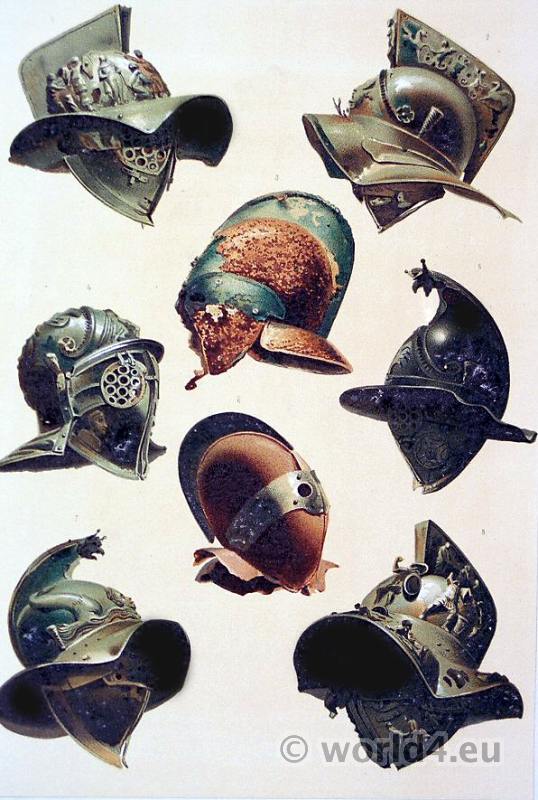
No. 17 – Hoplomachos; after the collection of clay lamps by Passeri. Under the empire Hoplomachos was called the gladiator in Samnite full armor *. Chain mail covering the whole body; long, arched scutum; closed helmet (see no. 11); Enemides or Ocreae ** on the left leg; straight sword.
*The Samnites were an ancient Italian tribe who lived in Samnium in central southern Italy. They were involved in several wars with the Roman Republic until the 1st century BC.
** Ocrea “, Plural” ocreae “, means leg splints that reached up to the thigh, often in leather, metal or wood, and in ancient times were used mainly by gladiators (Mirmillon, Thracians and Secutors) or generally by soldiers of all kinds with a minimum of armor.
The Ockrea was originally worn on the left leg, i.e. the guardian foot, so that the foot was placed forward in fencing because the shield was held in the left hand. Only the Thracian carried two ocreae.
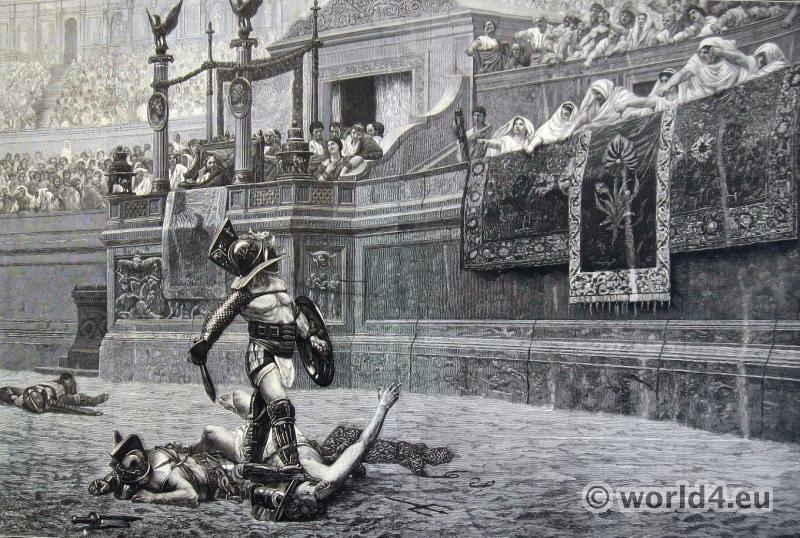
Number 32. – Retiarius. *
No. 36. – Detail of his armor.
The Retiarius* got its name from the reta, the net he tried to throw over the head of his opponent, the secutor, to attack him with the trident, fuscina or tridens.
The left arm, protected by a bronze shoulder piece and a chain mesh to which an iron glove is attached by leather straps (cf. No. 36). – Compestra pleated around the hips. – Leather belt with bronze humps. – Leather splints wrapped in bandages. – Caligae, releasing the toes.
*A Retiarius (plural retiarii; “net man” or “net fighter”) was a Roman gladiator who fought with combat equipment based on that of a fisherman: a heavy net (rete, hence the name), a trident (fuscina or tridens) and a dagger (pugio). The Retiarius was only lightly armored and wore only an arm guard (Manica) and a shoulder guard (Galerus). Usually, his clothing consisted only of a loincloth (subligaculum) held by a wide belt or a short tunic with light padding. He wore no headgear and no shoes.
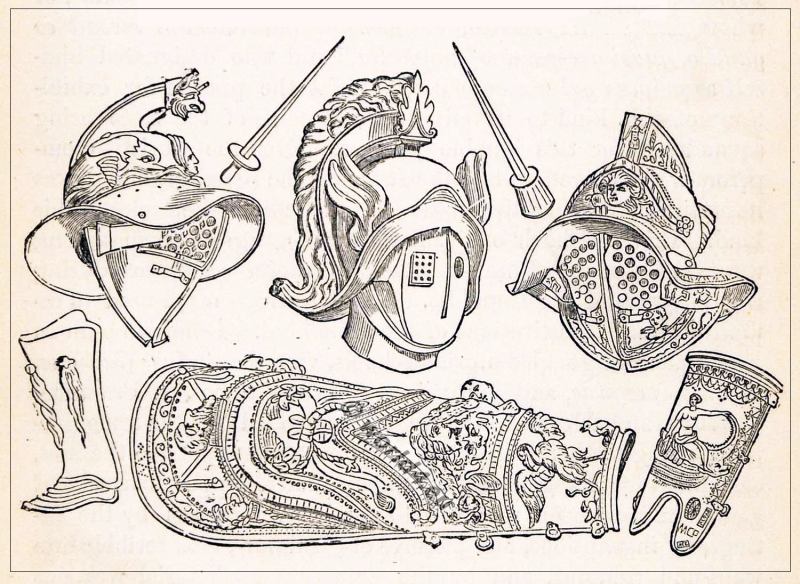
No. 2 and 13 – Legion eagle; according to commemorative coins, one with the inscription Caes. Aug., the other Q. F. Catus sex. Allius.
No. 16 – Pinea, fir cone, as he often adorned the tip of the signum.
No. 18 – Victoria with the vexillum;* after a medallion with inscription.
*The Vexillum was a banner-like object used as a military standard by units of the ancient Roman army. In the Vexillum, the cloth was draped from a horizontal crossbar suspended from the pole. This is in contrast to most modern flags where the “lift” of the cloth is attached directly to the vertical bar. The wearer of a Vexillum was known as Vexillarius or Vexillifer.
The only existing Roman military Vexillum dates from the first half of the 3rd century AD and is kept in the Pushkin Museum. It is an almost square piece of coarse linen with the image of the goddess Victoria and measures 47×50 cm. The lower margin has remains of a fringe. The Vexillum was once attached to a piece of reed. It is unknown to which military unit the Vexillum belonged. The Vexillum was found shortly before 1911 in Egypt, but its exact origin is unclear.
Nos. 5, 20 and 28. – Personifications of the Roma.
No. 5 after a coin with the inscription C. Licin: Varus and Numa Pompili.
No. 20 after a commemorative coin from the war against Jugurtha*.
*The Jugurthine War took place 112-106 B.C. between Rome and Jugurtha of Numidia, a kingdom on the North African coast approaching modern Algeria. Jugurtha was the nephew and adopted son of Micipsa, King of Numidia, whom he succeeded on the throne and defeated his rivals by murder, war and bribery.).
No. 28. – Commemorative coin from the Pompeian wars.
No. 31 – Horus, bronze figure from the last period of the Roman Empire, about 350 AD.
Costume of a Roman commander in chief in Egypt, completed by the sleep, the headscarf of the Egyptians.
No. 1, 2, 5, 13, 15, 16, 18, 20 and 28 according to Romanae et Graecae antiquitatis monumenta by H. Goltzius, Antwerp 1608.
No. 3, 4, 6, 7, 8, 9, 10, 11, 12, 14, 19, 21, 22, 23, 24, 25, 26, 27, 29, 30, 32, 33, 34, 35, 36 and 37 from the collection of war costumes in the Artillery Museum in Paris, under the direction of Colonel Leclercq.
No. 17 from the Antiquites of Mongez.
No. 31 Bronze statue in the British Museum.
See Duruy, Filon, Laxroix and Yanoski, l’Italie ancienne, Univers pittoresque, 1862.
Source: History of the costume in chronological development by Auguste Racinet. Edited by Adolf Rosenberg. Editor: Firmin-Didot et cie. Paris, 1888.
Related
Discover more from World4 Costume Culture History
Subscribe to get the latest posts sent to your email.

